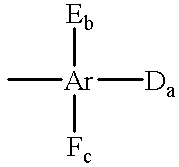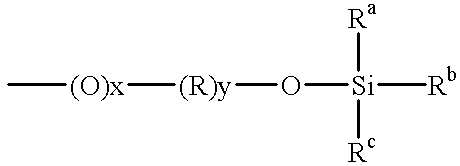Photoinitiators for cationic curing
a technology of photoinitiators and cationic curing, which is applied in the field of photoinitiators for cationic curing, can solve the problems of limited miscibility and solubility of photoinitiators, coatings that do not cure very well under ultraviolet light, and deficiency in miscibility with organopolysiloxanes, etc., and achieves good compatibility with organopolysiloxanes containing, high-efficiency and simpl
- Summary
- Abstract
- Description
- Claims
- Application Information
AI Technical Summary
Benefits of technology
Problems solved by technology
Method used
Image
Examples
example 1
10 g of commercial photoinitiator of the formula (VII) were dissolved in 20 g of tetrahydofuran (THF), and 2.78 g of octyldimethylchlorosilane and a few drops of N-methylimidazole were added to the clear solution. The mixture was heated to 60.degree. C. in a water bath and stirred for 4 h while passing in nitrogen. During this time, the THF solvent was replaced continually. Following the reaction, the solvent was removed by distillation, leaving a waxlike product.
example 2
10 g of commercial photoinitiator of formula (VII) were dissolved in 20 g of THF, and 10.81 g of hexamethyldisilazane were added to the clear solution. The mixture was stirred for 1 h, and then excess hexamethyldisilazane and solvent were removed under reduced pressure to leave a yellow, viscous product.
example 3
10 g of commercial photoinitiator of formula (VII) were dissolved in 20 g of THF, and 11 g of diphenyltetramethyldisilazane were added to the clear solution. The mixture was stirred for 1 h, and then excess diphenyltetramethyldisilazane and solvent were removed under reduced pressure to leave an amber-colored, viscous product.
PUM
| Property | Measurement | Unit |
|---|---|---|
| melting point | aaaaa | aaaaa |
| polarity | aaaaa | aaaaa |
| miscibility | aaaaa | aaaaa |
Abstract
Description
Claims
Application Information
 Login to View More
Login to View More - R&D
- Intellectual Property
- Life Sciences
- Materials
- Tech Scout
- Unparalleled Data Quality
- Higher Quality Content
- 60% Fewer Hallucinations
Browse by: Latest US Patents, China's latest patents, Technical Efficacy Thesaurus, Application Domain, Technology Topic, Popular Technical Reports.
© 2025 PatSnap. All rights reserved.Legal|Privacy policy|Modern Slavery Act Transparency Statement|Sitemap|About US| Contact US: help@patsnap.com



